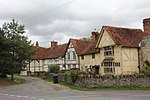East Hendred

East Hendred is a village and civil parish about 4 miles (6.4 km) east of Wantage in the Vale of White Horse and a similar distance west of Didcot. The village is on East Hendred Brook, which flows from the Berkshire Downs to join the River Thames at Sutton Courtenay. Historically in Berkshire, it has been administered as part of Oxfordshire, England, since the 1974 boundary changes. The westernmost parts of the Harwell Science and Innovation Campus are in the parish. The Ridgeway and Icknield Way pass through the parish. It was called "the most well connected village in Britain" because of its connections with the railway station in Didcot and the M4 motorway. Champs Chapel Museum of East Hendred is a small museum in a former 15th-century wayside chapel.
Excerpt from the Wikipedia article East Hendred (License: CC BY-SA 3.0, Authors, Images).East Hendred
Cat Street, Vale of White Horse
Geographical coordinates (GPS) Address Nearby Places Show on map
Geographical coordinates (GPS)
| Latitude | Longitude |
|---|---|
| N 51.596 ° | E -1.338 ° |
Address
Cat Street
OX12 8JT Vale of White Horse
England, United Kingdom
Open on Google Maps





